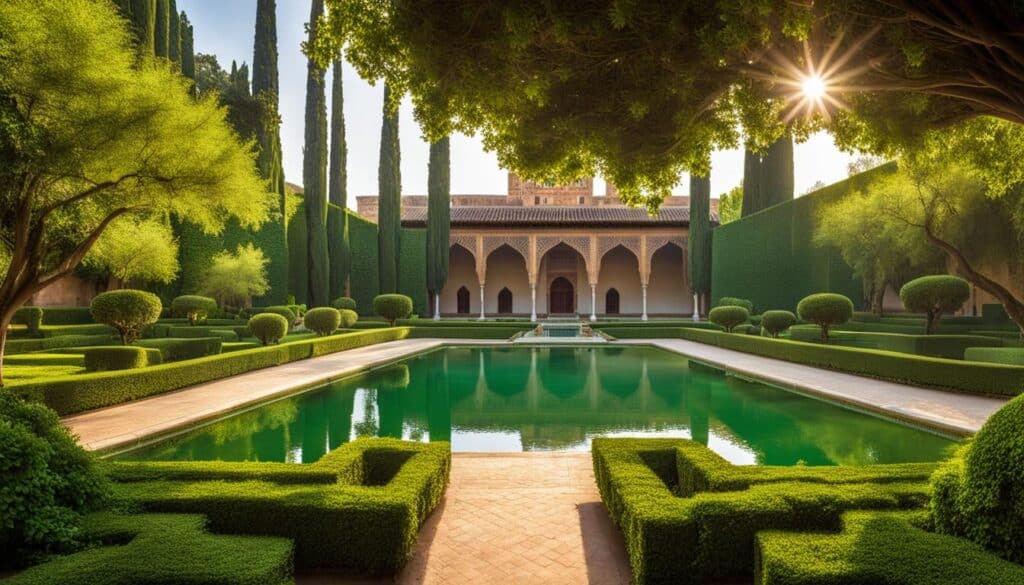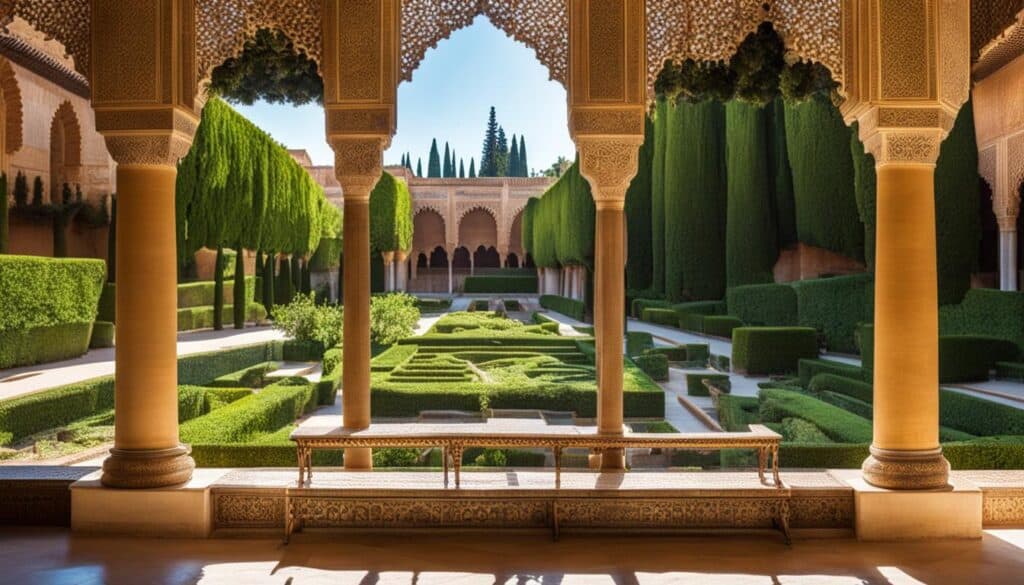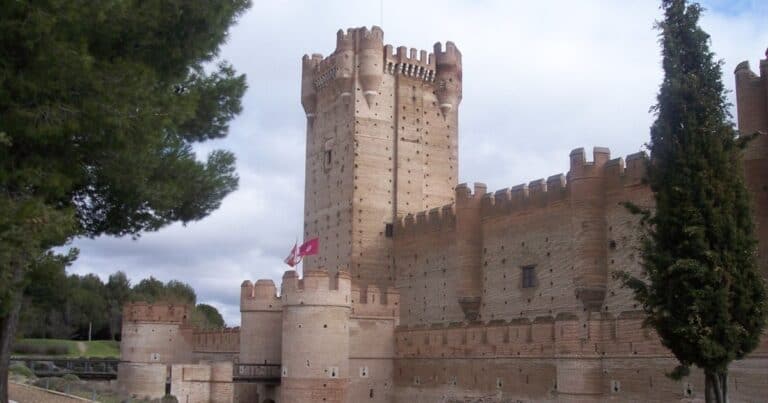Alhambra: A Tapestry of Moorish Splendor in Granada

I am excited to introduce you to the Alhambra, an architectural masterpiece nestled in the heart of Granada, Spain, and one of my favorite castles or palaces to visit in Spain. This UNESCO World Heritage Site is a testament to the incredible artistry and craftsmanship of the Moors, showcasing a captivating blend of Islamic, Christian, and Jewish cultures.
Originally built during the Nasrid dynasty in the 13th century, the Alhambra’s history and architecture have mesmerized visitors for centuries. From its stunning palaces and fortified walls to its exquisite gardens and intricate detailing, every corner of the Alhambra tells a story of its rich past.
Contents
- Preserving History: Efforts in Restoring and Maintaining the Alhambra Architectural Marvels
- Origins and Influences: Unraveling the Inspiration Behind the Alhambra Islamic Architecture
- The History and Architecture of Alhambra: Unveiling the Secrets of Granada Moorish Palace
- Unlocking the Beauty Within: A Journey through the Serene Gardens of Alhambra
- Symbolism and Meaning: Decoding the Hidden Messages Within the Alhambra Designs
- The Alhambra Palace Audio Tour: Unveiling the Splendor at Your Own Pace
- Conclusion
- FAQ
- How can I book tickets to visit the Alhambra?
- Can I visit the Alhambra without a guided tour?
- How can I learn more about the history and architecture of the Alhambra?
- Are the Alhambra gardens open to the public?
- What is the significance of the symbolism within the Alhambra designs?
- Are there self-guided audio tours available for the Alhambra Palace?
Key Takeaways:
- Discover the mesmerizing blend of Islamic, Christian, and Jewish cultures in the architecture of the Alhambra.
- Learn about the ongoing efforts to restore and preserve the Alhambra’s architectural marvels.
- Unravel the inspiration behind Alhambra’s Islamic architecture and its influences from the Nasrid dynasty and Andalusian traditions.
- Explore the history of the Alhambra, from its origins as a small fortress to its transformation into a royal palace.
- Immerse yourself in the serene gardens of the Alhambra, designed with Islamic garden principles and offering not only aesthetic beauty but also wellness benefits.
Preserving History: Efforts in Restoring and Maintaining the Alhambra Architectural Marvels
The Alhambra, with its breathtaking architectural marvels, requires continuous restoration and maintenance to preserve its beauty. Over time, weather conditions have taken a toll on the intricate surfaces, resulting in cracks and erosion. Addressing these challenges requires the expertise of specialized craftsmen and the implementation of innovative technologies.
Restoration initiatives at the Alhambra employ state-of-the-art techniques such as 3D laser scanning. This technology allows for precise documentation and analysis of the architectural elements, facilitating the restoration process. By capturing highly accurate measurements and details, craftsmen can recreate the original features, ensuring authenticity and preserving the historical significance of the site.
Besides utilizing advanced technologies, sustainable preservation practices are also embraced at the Alhambra. The preservation team aims to minimize environmental impact while safeguarding the structural integrity of the architectural gems. By adopting eco-friendly approaches, such as using environmentally friendly materials and energy-efficient systems, the Alhambra sets an example for future restoration projects.
The preservation and restoration efforts undertaken at the Alhambra contribute not only to the physical preservation of the site but also to the perpetuation of cultural heritage. By protecting and maintaining the architectural marvels, the Alhambra ensures that future generations can experience and appreciate the grandeur of this historic gem.
Take a look at the image below showcasing the delicate restoration process at the Alhambra:
Through meticulous restoration and preservation initiatives, the Alhambra continues to captivate visitors and stand as a testament to the incredible craftsmanship of the Moors. In the upcoming sections, we will delve deeper into the origins and influences of the Alhambra’s Islamic architecture, explore its stunning gardens, and unravel the hidden messages within its designs.
Origins and Influences: Unraveling the Inspiration Behind the Alhambra Islamic Architecture
The exquisite architecture of the Alhambra Palace is deeply rooted in Islamic traditions, reflecting the historical influences of the Nasrid dynasty and Andalusian architecture. Combining elements of Alhambra architecture, Moorish architecture, and Islamic architecture, this awe-inspiring masterpiece showcases the artistic and cultural heritage of its time.
At the heart of the Alhambra’s design philosophy are the Islamic art and design principles that permeate every detail of its construction. From the iconic arches that define its structural form to the intricate calligraphy etched onto its walls, every element is a tribute to the rich artistic traditions of the Islamic world.
The Alhambra’s architecture also showcases the influence of Moorish, Byzantine, and Spanish cultures, resulting in a captivating fusion of architectural styles. The incorporation of ornamental geometric patterns and mihrabs, which indicate the direction of Mecca, highlights the harmony between spiritual devotion and artistic expression.
One of the defining features of Alhambra architecture is the use of ornate courtyards, known as “patios,” which serve as tranquil retreats within the palace complex. These courtyards embody the concept of “paradise on earth,” with lush gardens, serene pools, and intricately designed fountains.
The Influence of Islamic Architecture
The Alhambra Palace draws heavily from the Islamic architectural traditions prevalent during the Nasrid dynasty. This dynasty ruled over the Emirate of Granada, which encompassed a vibrant Andalusian society heavily influenced by Islamic culture.
The Islamic architectural influences evident in the Alhambra can be traced back to the Islamic Golden Age, a period of significant cultural and intellectual advancements. During this time, Islamic scholars and artisans developed a unique architectural style characterized by geometric precision, refined ornamentation, and a focus on creating harmonious spaces.
The Alhambra’s architecture reflects the meticulous attention to detail and the spiritual symbolism intrinsic to Islamic design. The integration of intricate geometric patterns, such as star motifs and elaborate mosaics, creates a mesmerizing visual effect, symbolizing the cosmic order and the infinite nature of the universe.
Islamic calligraphy, another prominent feature of Alhambra architecture, plays a dual role. It serves as a form of artistic expression, showcasing the beauty of the written word, while also conveying religious messages and invoking a sense of spiritual devotion.
Influences on Alhambra Architecture
| Architectural Influence | Description |
|---|---|
| Moorish Architecture | Incorporated design elements and construction techniques from the Moors, who were of North African and Arab descent and played a significant role in shaping Andalusian culture. |
| Byzantine Architecture | Infused Byzantine architectural features, such as intricate mosaics and vibrant decorative elements inspired by the Byzantine Empire’s artistic traditions. |
| Spanish Architecture | Integrated elements from Spanish architectural styles prevalent during the time, resulting in a fusion of cultural influences within the Alhambra’s design. |
The Alhambra’s origins and influences tell a captivating story of cultural exchange and artistic innovation. From its Islamic architectural roots to the amalgamation of diverse influences, this architectural marvel continues to inspire awe and admiration for its rich history and timeless beauty.
The History and Architecture of Alhambra: Unveiling the Secrets of Granada Moorish Palace
The Alhambra’s history can be traced back to the 9th century when it served as a small fortress. However, in the 13th century, it underwent a remarkable transformation under the Nasrid dynasty to become the grand royal palace we see today. This architectural masterpiece showcases a mesmerizing blend of intricate carvings, stunning courtyards, and formidable defensive structures.
Following the Christian Reconquest, the Alhambra underwent modifications to align with the preferences of Christian rulers. Despite these alterations, the essence of the original Moorish architecture remains intact, representing a fusion of Islamic, Christian, and Jewish influences.
Today, the Alhambra stands proudly as a UNESCO World Heritage site, drawing millions of visitors from around the world who are eager to unravel its secrets and marvel at its magnificence.
Unlocking the Beauty Within: A Journey through the Serene Gardens of Alhambra
The gardens of the Alhambra are a peaceful retreat, embodying the principles of Islamic garden design. These meticulously crafted gardens are a testament to the beauty of nature, showcasing the seamless blend of architecture and landscaping. From the thematic gardens to the intricate water features, every element is designed to evoke a sense of tranquility and harmony.
Imagine strolling through the Alhambra gardens, surrounded by lush greenery, vibrant flowers, and the soothing sound of water gently cascading down fountains. Each garden represents a different theme, offering a unique sensory experience. Whether it’s the fragrant rose garden, the serene courtyard filled with orange trees, or the neatly manicured hedges, every corner reveals a new facet of Alhambra’s beauty.
Did you know? The Generalife gardens, adjacent to the Alhambra, are a stunning extension of this serene oasis. They were originally created as a leisure retreat for the Nasrid rulers, with terraces, pergolas, and pavilions offering breathtaking views of the Alhambra and the surrounding landscape.

Gardens as a Source of Wellness
Beyond their aesthetic appeal, the Alhambra Gardens provide wellness benefits that contribute to a truly immersive experience. Walking through these serene spaces can help relieve stress and promote relaxation. The combination of lush greenery, soothing water features, and the overall ambiance of the gardens creates an environment conducive to tranquility and mindfulness.
Furthermore, studies have shown that spending time in nature can enhance concentration and boost overall well-being. The Alhambra Gardens offer visitors a chance to reconnect with nature and find respite from the demands of daily life. Whether it’s sitting by a tranquil pool, leisurely strolling through maze-like pathways, or finding a serene spot to meditate, the gardens provide an opportunity for visitors to rejuvenate their senses.
Celebrating Cultural Heritage and Symbolism
The Alhambra Gardens are not only a testament to the architectural brilliance of the Nasrid dynasty but also a celebration of Islamic art and symbolism. Each element within the gardens holds significance and tells a story.
- The use of water features, such as fountains and pools, represents purification and the concept of life flowing. Water is considered an art form in Islamic gardens, bringing a sense of calmness and coolness to the surroundings.
- The intricate courtyard designs showcase geometric patterns, symbolizing harmony and unity. These patterns, often crafted with colorful tiles, reflect the mathematical precision and attention to detail that defines Islamic art.
- The Generalife gardens, with their terraces and viewpoints, embody the concept of paradise within the Islamic tradition. These elevated spaces provide breathtaking views of the Alhambra and its surroundings, creating a sense of serenity and transcendence.
In summary, the Alhambra Gardens are a journey through beauty, nature, and culture. They offer visitors a chance to immerse themselves in the peaceful atmosphere and experience the harmonious combination of architecture and nature. The gardens’ wellness benefits, cultural heritage, and symbolic elements make them an integral part of the Alhambra experience, captivating the hearts and minds of all who visit.
Symbolism and Meaning: Decoding the Hidden Messages Within the Alhambra Designs
The designs within the Alhambra are not only visually stunning but also rich in symbolism, conveying deeper meanings and concepts. Every intricate detail holds significance and reflects the artistic and cultural heritage of the palace. Let’s unravel some of the hidden messages embedded within the Alhambra’s exquisite designs.
1. The Star Motif: Symbolizing the Cosmos
One of the prominent motifs found throughout the Alhambra is the star motif. This design element represents the cosmos and our place within the universe. The intricate patterns of the stars symbolize the harmony and interconnectedness of all things. As you gaze upon the star-filled ceilings and walls, you can’t help but marvel at the celestial grandeur that the Alhambra captures.
2. Calligraphy Inscriptions: Religious Devotion and Artistic Expression
Within the Alhambra, calligraphy plays a significant role in conveying both religious devotion and artistic expression. Arabic calligraphy, with its flowing lines and ornate curves, adorns the walls and archways of the palace. These inscriptions often include verses from the Quran, showcasing the spirituality and reverence of the Islamic culture. The calligraphy also serves as a form of artistic expression, highlighting the beauty of the written word.
3. Mihrabs: Focal Points and Sacred Direction
The Alhambra’s designs include mihrabs, which are decorative elements indicating the direction of Mecca, the holiest city in Islam. Mihrabs serve as focal points, aligning the faithful with their place of worship and encouraging contemplation and connection with the divine. The intricate detailing of these mihrabs adds to the spiritual ambiance of the Alhambra, creating a sense of reverence within its walls.
4. Ornamental Geometric Patterns: Visual Mastery
When exploring the Alhambra, you can’t help but be captivated by the mesmerizing ornamental geometric patterns. These designs are intricately woven together, creating stunning visual effects that seem to dance before your eyes. The precision and symmetry of these patterns reflect the meticulous craftsmanship of the artisans who created them. These geometric motifs represent harmony, balance, and order, further enhancing the beauty of the Alhambra’s architecture.
5. Courtyards and Gardens: A Serene Retreat
While not strictly designs, the courtyards and gardens within the Alhambra hold symbolic significance. These tranquil spaces provide a serene retreat within the palace complex, offering respite from the bustling world outside. The meticulously landscaped gardens, with their lush greenery and flowing water features, embody the harmony of nature and the human spirit. They serve not only as aesthetic elements but also as a reflection of the importance of nature in Islamic art and symbolism.
In summary, the designs within the Alhambra are not only visually captivating but also carry profound meanings. From the star motifs symbolizing the cosmos to the calligraphy inscriptions denoting religious devotion, each design element tells a story and adds to the richness of the Alhambra’s cultural heritage. Exploring these hidden messages allows us to gain a deeper appreciation for the art, symbolism, and historical significance of this architectural masterpiece.
The Alhambra Palace Audio Tour: Unveiling the Splendor at Your Own Pace
Exploring the Alhambra Palace has never been more captivating with the convenience of a self-guided audio tour. This immersive experience allows visitors to delve into the rich history, awe-inspiring architecture, and cultural significance of the palace while exploring at their own pace.
The audio tour provides fascinating stories and insights that bring the Alhambra to life. Visitors will uncover the secrets behind the intricate carvings, learn about the influential Nasrid dynasty, and discover the hidden symbolism within the designs. With informative commentary, they will gain a deeper understanding of the Alhambra’s significance in Moorish architecture and Islamic art.
Accessible through a user-friendly smartphone app, the audio tour offers a seamless navigation experience. Visitors can effortlessly navigate through the various areas of the palace, ensuring they don’t miss any of its treasures. Whether strolling through the breathtaking courtyards or admiring the ornate detailing, the audio tour provides valuable insights, enhancing the overall Alhambra experience.
Embarking on a self-guided audio tour empowers visitors to choose their own path, spending more time in areas that pique their interest. It allows them to pause, reflect, and fully absorb the splendor of the Alhambra at their leisure. This flexibility is particularly beneficial for those who prefer a more personalized and intimate exploration of this magnificent architectural wonder.
Whether you’re a history enthusiast, an architecture lover, or simply curious about the Alhambra’s cultural heritage, the audio tour is an essential companion during your visit. It provides a wealth of knowledge and a deeper appreciation for the splendor that awaits within the palace walls.

Immerse yourself in the beauty and history of the Alhambra Palace with the convenience of a self-guided audio tour. Discover the intricate details, unravel the hidden symbolism, and uncover the stories behind this architectural marvel at your own pace.
Conclusion
The Alhambra Palace in Granada, Spain, is a masterpiece that exemplifies the incredible artistry and cultural significance of Moorish architecture. With its rich history, breathtaking architecture, vibrant gardens, and intricate hidden symbolism, the Alhambra is a destination that should not be missed.
Thanks to ongoing restoration and preservation efforts, the Alhambra continues to enchant visitors and foster appreciation for its architectural marvels. As you explore the gardens, decode the hidden messages, or embark on a self-guided audio tour, you will be transported to a bygone era, immersed in the beauty and grandeur of this magnificent palace.
Whether you are interested in the Alhambra’s history, fascinated by its architectural intricacies, or simply seeking a serene retreat within the bustling city of Granada, the Alhambra offers an experience that is bound to leave a lasting impression. Discover the allure of this UNESCO World Heritage Site and witness the magnificence of Moorish splendor firsthand at the Alhambra Palace.
The Alhambra is truly an amazing place, and certainly one of the finest palaces or castles in Spain.
FAQ
How can I book tickets to visit the Alhambra?
To book tickets to visit the Alhambra, you can visit the official website or use authorized ticket vendors. Online ticket booking is recommended to secure your preferred date and time of entry.
Can I visit the Alhambra without a guided tour?
Yes, you can explore the Alhambra at your own pace without a guided tour. However, guided tours are available and provide fascinating insights into the history, architecture, and cultural significance of the palace.
How can I learn more about the history and architecture of the Alhambra?
There are numerous resources available to learn more about the history and architecture of the Alhambra. You can visit the official website, read books and articles, join guided tours, or listen to audio guides that provide detailed information about the palace.
Are the Alhambra gardens open to the public?
Yes, the Alhambra gardens, including the Generalife gardens, are open to the public. Visitors can explore the beautiful gardens and experience the tranquility of Islamic garden design principles.
What is the significance of the symbolism within the Alhambra designs?
The symbolism within the Alhambra designs conveys deeper meanings and concepts. For example, the star motif represents the cosmos, calligraphy inscriptions convey religious devotion, mihrabs indicate the direction of Mecca, and ornamental geometric patterns create stunning visual effects.
Are there self-guided audio tours available for the Alhambra Palace?
Yes, there are self-guided audio tours available for the Alhambra Palace. These tours can be accessed through a smartphone app, allowing visitors to explore the palace at their own pace while learning about its treasures and history.





